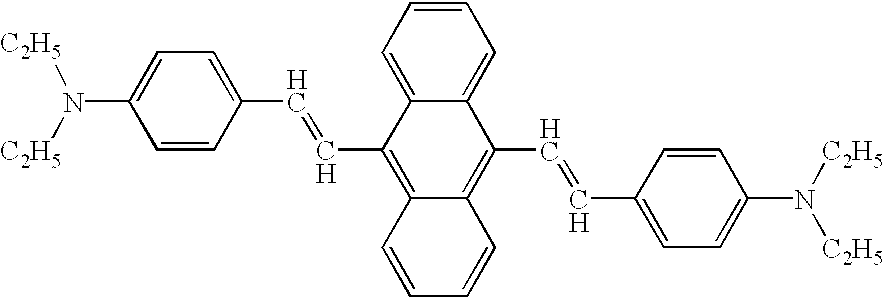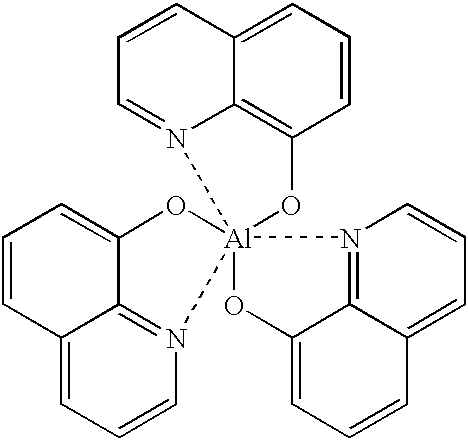EL device with insulating layer of a bromide or iodide
a thin film, bromide or iodide technology, applied in the direction of discharge tube/lamp details, luminescent screen, discharge tube/lamp details, etc., can solve the problems of poor electron injection efficiency, difficult to obtain stable properties of cathodes, and unstable properties
- Summary
- Abstract
- Description
- Claims
- Application Information
AI Technical Summary
Benefits of technology
Problems solved by technology
Method used
Image
Examples
embodiment 3
First, ITO films were formed to a thickness of 200 nm on glass substrates of 50 mm square by sputtering and then patterned to have stripes of 2 mm width. After water washing, the resulting substrates were supersonically washed in water for 10 minutes, supersonically washed in acetone for 10 minutes, washed with vapor of isopropyl alcohol for 5 minutes and dried in a dryer at 100.degree. C. for an hour.
Next, the resulting substrates were fixed on substrate holders in a resistive heating deposition apparatus. The pressure in the apparatus was then reduced to a vacuum of 1.times.10.sup.-4 Pa.
Afterwards, N,N'-diphenyl-N,N'-bis(1-naphthyl) 1,1-biphenyl-4,4-diamine (hereinafter referred to as NPD) represented by the following formula: ##STR2##
was deposited as hole transporting layers to a thickness of 50 nm at a deposition rate of 0.2 nm / sec.
Subsequently, tris(8-hydroxyquinolinate)aluminum (hereinafter referred to as Alq.sub.3) represented by the following formula: ##STR3##
was deposited a...
embodiment 4
Another nine kinds of organic EL devices were produced in the same manner as in Embodiment 3 except that Mg and Ag were co-deposited at deposition rates of 0.4 nm / sec. and 0.04 nm / sec., respectively, to a thickness of 200 nm as cathodes instead of aluminum.
embodiment 5
First, ITO films were formed to a thickness of 200 nm on glass substrates of 50 mm square by sputtering and then patterned to have stripes of 2 mm width. After water washing, the resulting substrates were supersonically washed in water for 10 minutes, supersonically washed in acetone for 10 minutes, washed with vapor of isopropyl alcohol for 5 minutes and dried in a dryer at 100.degree. C. for an hour.
Next, the resulting substrates were fixed on substrate holders in a resistive heating deposition apparatus. The pressure in the apparatus was then reduced to a vacuum of 1.times.10.sup.-4 Pa.
Afterwards, 1,1,4,4,-tetraphenyl-1,3-butadiene (hereinafter referred to as TPB) represented by the following formula: ##STR4##
was deposited as light emitting layers to a thickness of 50 nm at a deposition rate of 0.2 nm / sec.
Subsequently, 2,(4-t-butylphenyl)-5-(4-biphenylyl)-1,3,4-oxazole (hereinafter referred to as tBu-PBD ) represented by the following formula: ##STR5##
was deposited to a thickness...
PUM
| Property | Measurement | Unit |
|---|---|---|
| thickness | aaaaa | aaaaa |
| work function | aaaaa | aaaaa |
| work function | aaaaa | aaaaa |
Abstract
Description
Claims
Application Information
 Login to View More
Login to View More - R&D
- Intellectual Property
- Life Sciences
- Materials
- Tech Scout
- Unparalleled Data Quality
- Higher Quality Content
- 60% Fewer Hallucinations
Browse by: Latest US Patents, China's latest patents, Technical Efficacy Thesaurus, Application Domain, Technology Topic, Popular Technical Reports.
© 2025 PatSnap. All rights reserved.Legal|Privacy policy|Modern Slavery Act Transparency Statement|Sitemap|About US| Contact US: help@patsnap.com



